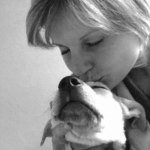
Stressors can include physiologic (such as pain, thirst, hunger, and illness), psychosocial (such as unfamiliar people or animals, being separated from the owner or familiar environment) and things in the environment (such as odors, noises, temperature/humidity, and pheromones from other animals). When an animal is stressed out, they can respond in two ways; they can have an immediate stress response or have a delayed stress response.
Stress, especially chronic stress, can have a variety of effects on the body. Some of the effects from chronic stress include delayed wound healing, suppression of the immune system, gastrointestinal disease, and behavioral disorders. When these stressors are not identified and addressed, these effects may progress and worsen.
Ways to identify if your pet is stressed include body language and behavior. Here are some body language cues to watch for in your pet to help you figure out if your pet is stressed out (not a complete list).
| Dogs | Cats |
| Wrinkled brow, lips pulled back, Growling or barking | Growling or hissing or spitting |
| Pacing | Pacing, attempt to hide or escape |
| Dilated pupils (large and round) | Dilated pupils (large and round) |
| High above topline, tucked, or wagging | Thumping of the tail |
| Ears flat against head, far forward or out to the side | Ears flat against head or out to the side |
| Rigid posture | Body crouched; legs tucked under body |
How to Help
Ways to help alleviate stress in your pet include pheromones (sprays, collars, or plug ins), supplements (please discuss with your pet’s primary care veterinarian for the most appropriate supplement for your pet), calming music (such as classical), or a quiet area to retreat to.
If your pet’s stress leads to behavioral issues, then discussing your behavioral concerns with their primary care veterinarian or a board-certified/residency trained veterinary behaviorist is recommended. Many times the underlying cause of stress can be identified and therapy options can be recommended. Other helpful therapies for stress and anxiety include acupuncture, herbal therapies, food therapy, and manual therapies.
Low stress handling techniques with positive reinforcement is encouraged and should be implemented every day. Managing stress can take time and consistency is key to have a happy pet.




